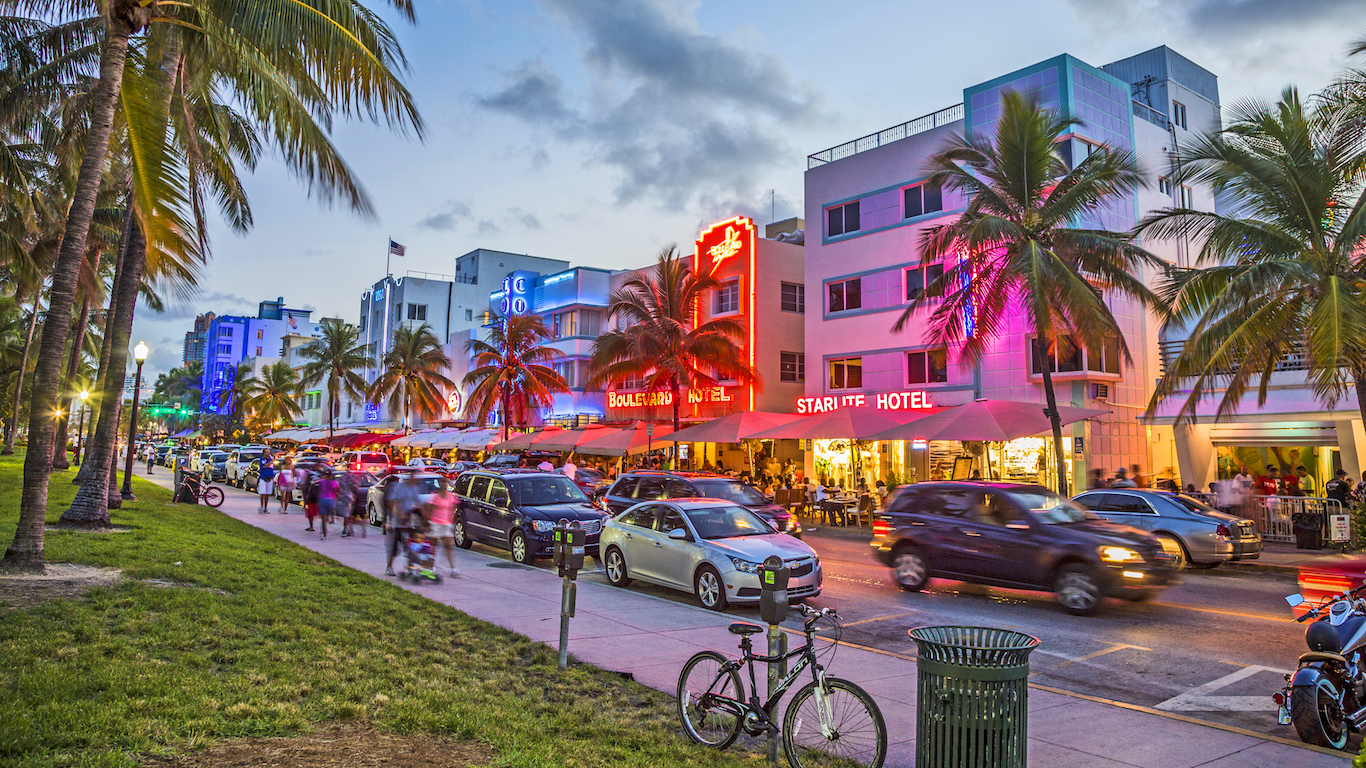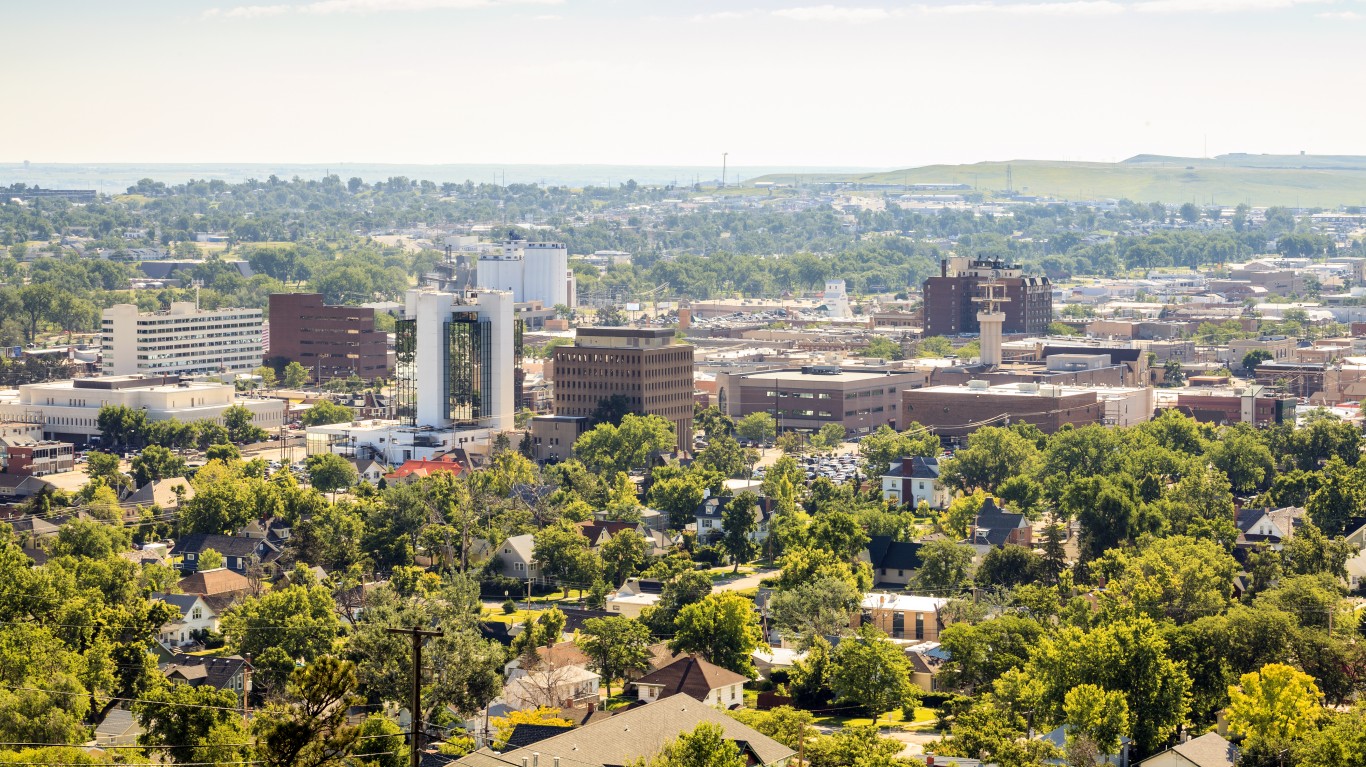Special Report
Income It Takes to Be Considered Rich in Every State

Published:
Last Updated:

A recent survey conducted by YouGov, a London based research group, asked Americans to identify what annual salary they would need to earn to consider themselves rich. The results varied widely, but most Americans place the threshold somewhere between $90,000 and $100,000. In addition to shedding light on the prevailing perceptions of financial prosperity in the United States, the survey also highlights the subjective nature of what qualifies as rich, and what does not.
For many Americans, the answer to what it means to be rich is likely relative — as in, how much money it takes to earn more than the vast majority of other people. According to data from the U.S. Census Bureau, the wealthiest 20% of households nationwide earn over $125,322 a year. However, exactly how much it takes to fall into the highest quintile of earners varies widely by state.
24/7 Wall St. reviewed the lower limit of income for the highest earning 20% of households to identify how much it takes to be considered rich in each state. In some parts of the country, an annual household income of $92,000 is enough, while in others, only households that make over $160,000 rank among the highest earners. In states where the wealthiest residents earn the most, incomes tend to be higher overall. Here is a ranking of America’s richest and poorest states.
Just as the amount of money it takes to be among the highest earners varies by state, so too does the cost of living. Across all states, the cost of living ranges from 18.5% more expensive than national average prices to 14.3% less expensive. In states where it takes more money to rank in the top 20%, cost of living tends to be higher than average. Conversely, in states where it takes less income to rank among the highest earners, the cost of living tends to be lower. Differences in cost of living can be even more pronounced at the city level. Here is a look at the most expensive city in every state.
Click here to see the income it takes to be considered rich in every state
Click here to read our methodology

1. Alabama
> Min. annual income to be in the top 20%: $101,051 per household (6th lowest)
> Income controlled by highest 20% of earners: 51.4% (14th highest)
> Min. annual income to be in the top 5%: $182,940 per household (7th lowest)
> Median household income: $49,861 (6th lowest)
> Cost of living: 13.3% less expensive than U.S. avg.
[in-text-ad]

2. Alaska
> Min. annual income to be in the top 20%: $138,860 per household (11th highest)
> Income controlled by highest 20% of earners: 47.1% (2nd lowest)
> Min. annual income to be in the top 5%: $240,603 per household (13th highest)
> Median household income: $74,346 (8th highest)
> Cost of living: 4.4% more expensive than U.S. avg.

3. Arizona
> Min. annual income to be in the top 20%: $115,276 per household (24th highest)
> Income controlled by highest 20% of earners: 49.9% (23rd lowest)
> Min. annual income to be in the top 5%: $210,702 per household (23rd highest)
> Median household income: $59,246 (24th lowest)
> Cost of living: 3.6% less expensive than U.S. avg.

4. Arkansas
> Min. annual income to be in the top 20%: $95,453 per household (3rd lowest)
> Income controlled by highest 20% of earners: 52.0% (6th highest)
> Min. annual income to be in the top 5%: $174,655 per household (3rd lowest)
> Median household income: $47,062 (3rd lowest)
> Cost of living: 13.5% less expensive than U.S. avg.
[in-text-ad-2]

5. California
> Min. annual income to be in the top 20%: $154,402 per household (5th highest)
> Income controlled by highest 20% of earners: 52.3% (4th highest)
> Min. annual income to be in the top 5%: 250,000+ per household (tied – the highest)
> Median household income: $75,277 (6th highest)
> Cost of living: 14.8% more expensive than U.S. avg.

6. Colorado
> Min. annual income to be in the top 20%: $138,050 per household (12th highest)
> Income controlled by highest 20% of earners: 49.3% (18th lowest)
> Min. annual income to be in the top 5%: $248,654 per household (12th highest)
> Median household income: $71,953 (11th highest)
> Cost of living: 3.2% more expensive than U.S. avg.
[in-text-ad]

7. Connecticut
> Min. annual income to be in the top 20%: $155,975 per household (4th highest)
> Income controlled by highest 20% of earners: 53.3% (2nd highest)
> Min. annual income to be in the top 5%: 250,000+ per household (tied – the highest)
> Median household income: $76,348 (5th highest)
> Cost of living: 8.0% more expensive than U.S. avg.

8. Delaware
> Min. annual income to be in the top 20%: $121,908 per household (19th highest)
> Income controlled by highest 20% of earners: 49.3% (19th lowest)
> Min. annual income to be in the top 5%: $221,861 per household (20th highest)
> Median household income: $64,805 (16th highest)
> Cost of living: 0.1% more expensive than U.S. avg.

9. Florida
> Min. annual income to be in the top 20%: $111,268 per household (20th lowest)
> Income controlled by highest 20% of earners: 52.5% (3rd highest)
> Min. annual income to be in the top 5%: $214,546 per household (22nd highest)
> Median household income: $55,462 (14th lowest)
> Cost of living: 0.1% less expensive than U.S. avg.
[in-text-ad-2]

10. Georgia
> Min. annual income to be in the top 20%: $117,795 per household (22nd highest)
> Income controlled by highest 20% of earners: 51.6% (11th highest)
> Min. annual income to be in the top 5%: $223,928 per household (17th highest)
> Median household income: $58,756 (23rd lowest)
> Cost of living: 7.5% less expensive than U.S. avg.

11. Hawaii
> Min. annual income to be in the top 20%: $149,347 per household (6th highest)
> Income controlled by highest 20% of earners: 48.0% (5th lowest)
> Min. annual income to be in the top 5%: 250,000+ per household (tied – the highest)
> Median household income: $80,212 (3rd highest)
> Cost of living: 18.5% more expensive than U.S. avg.
[in-text-ad]

12. Idaho
> Min. annual income to be in the top 20%: $103,736 per household (12th lowest)
> Income controlled by highest 20% of earners: 48.7% (11th lowest)
> Min. annual income to be in the top 5%: $184,634 per household (10th lowest)
> Median household income: $55,583 (15th lowest)
> Cost of living: 7.0% less expensive than U.S. avg.

13. Illinois
> Min. annual income to be in the top 20%: $130,780 per household (14th highest)
> Income controlled by highest 20% of earners: 51.8% (8th highest)
> Min. annual income to be in the top 5%: $249,232 per household (11th highest)
> Median household income: $65,030 (15th highest)
> Cost of living: 1.5% less expensive than U.S. avg.

14. Indiana
> Min. annual income to be in the top 20%: $105,178 per household (14th lowest)
> Income controlled by highest 20% of earners: 48.7% (12th lowest)
> Min. annual income to be in the top 5%: $181,990 per household (6th lowest)
> Median household income: $55,746 (17th lowest)
> Cost of living: 10.2% less expensive than U.S. avg.
[in-text-ad-2]

15. Iowa
> Min. annual income to be in the top 20%: $110,323 per household (19th lowest)
> Income controlled by highest 20% of earners: 47.9% (4th lowest)
> Min. annual income to be in the top 5%: $193,635 per household (16th lowest)
> Median household income: $59,955 (25th highest)
> Cost of living: 10.2% less expensive than U.S. avg.

16. Kansas
> Min. annual income to be in the top 20%: $111,928 per household (23rd lowest)
> Income controlled by highest 20% of earners: 50.0% (25th lowest)
> Min. annual income to be in the top 5%: $201,686 per household (24th lowest)
> Median household income: $58,218 (21st lowest)
> Cost of living: 10.0% less expensive than U.S. avg.
[in-text-ad]

17. Kentucky
> Min. annual income to be in the top 20%: $101,038 per household (5th lowest)
> Income controlled by highest 20% of earners: 51.1% (16th highest)
> Min. annual income to be in the top 5%: $183,084 per household (8th lowest)
> Median household income: $50,247 (7th lowest)
> Cost of living: 12.1% less expensive than U.S. avg.

18. Louisiana
> Min. annual income to be in the top 20%: $103,709 per household (11th lowest)
> Income controlled by highest 20% of earners: 52.2% (5th highest)
> Min. annual income to be in the top 5%: $189,759 per household (13th lowest)
> Median household income: $47,905 (5th lowest)
> Cost of living: 9.9% less expensive than U.S. avg.

19. Maine
> Min. annual income to be in the top 20%: $108,613 per household (16th lowest)
> Income controlled by highest 20% of earners: 48.6% (10th lowest)
> Min. annual income to be in the top 5%: $188,137 per household (12th lowest)
> Median household income: $55,602 (16th lowest)
> Cost of living: 1.6% less expensive than U.S. avg.
[in-text-ad-2]

20. Maryland
> Min. annual income to be in the top 20%: $160,049 per household (3rd highest)
> Income controlled by highest 20% of earners: 48.9% (14th lowest)
> Min. annual income to be in the top 5%: 250,000+ per household (tied – the highest)
> Median household income: $83,242 (the highest)
> Cost of living: 9.4% more expensive than U.S. avg.

21. Massachusetts
> Min. annual income to be in the top 20%: $161,154 per household (2nd highest)
> Income controlled by highest 20% of earners: 51.6% (10th highest)
> Min. annual income to be in the top 5%: 250,000+ per household (tied – the highest)
> Median household income: $79,835 (4th highest)
> Cost of living: 7.9% more expensive than U.S. avg.
[in-text-ad]

22. Michigan
> Min. annual income to be in the top 20%: $111,460 per household (21st lowest)
> Income controlled by highest 20% of earners: 50.3% (25th highest)
> Min. annual income to be in the top 5%: $201,811 per household (25th lowest)
> Median household income: $56,697 (20th lowest)
> Cost of living: 7.0% less expensive than U.S. avg.

23. Minnesota
> Min. annual income to be in the top 20%: $132,288 per household (13th highest)
> Income controlled by highest 20% of earners: 49.0% (15th lowest)
> Min. annual income to be in the top 5%: $236,919 per household (14th highest)
> Median household income: $70,315 (13th highest)
> Cost of living: 2.5% less expensive than U.S. avg.

24. Mississippi
> Min. annual income to be in the top 20%: $91,115 per household (the lowest)
> Income controlled by highest 20% of earners: 51.1% (17th highest)
> Min. annual income to be in the top 5%: $165,586 per household (2nd lowest)
> Median household income: $44,717 (2nd lowest)
> Cost of living: 14.3% less expensive than U.S. avg.
[in-text-ad-2]

25. Missouri
> Min. annual income to be in the top 20%: $106,984 per household (15th lowest)
> Income controlled by highest 20% of earners: 50.3% (24th highest)
> Min. annual income to be in the top 5%: $199,373 per household (22nd lowest)
> Median household income: $54,478 (12th lowest)
> Cost of living: 10.5% less expensive than U.S. avg.

26. Montana
> Min. annual income to be in the top 20%: $102,785 per household (9th lowest)
> Income controlled by highest 20% of earners: 49.1% (16th lowest)
> Min. annual income to be in the top 5%: $183,849 per household (9th lowest)
> Median household income: $55,328 (13th lowest)
> Cost of living: 5.4% less expensive than U.S. avg.
[in-text-ad]

27. Nebraska
> Min. annual income to be in the top 20%: $111,601 per household (22nd lowest)
> Income controlled by highest 20% of earners: 48.6% (10th lowest)
> Min. annual income to be in the top 5%: $195,327 per household (17th lowest)
> Median household income: $59,566 (25th lowest)
> Cost of living: 10.4% less expensive than U.S. avg.

28. Nevada
> Min. annual income to be in the top 20%: $113,505 per household (25th lowest)
> Income controlled by highest 20% of earners: 50.5% (22nd highest)
> Min. annual income to be in the top 5%: $204,709 per household (25th highest)
> Median household income: $58,646 (22nd lowest)
> Cost of living: 2.4% less expensive than U.S. avg.

29. New Hampshire
> Min. annual income to be in the top 20%: $141,322 per household (10th highest)
> Income controlled by highest 20% of earners: 48.8% (13th lowest)
> Min. annual income to be in the top 5%: 250,000+ per household (tied – the highest)
> Median household income: $74,991 (7th highest)
> Cost of living: 5.8% more expensive than U.S. avg.
[in-text-ad-2]

30. New Jersey
> Min. annual income to be in the top 20%: $164,995 per household (the highest)
> Income controlled by highest 20% of earners: 51.5% (12th highest)
> Min. annual income to be in the top 5%: 250,000+ per household (tied – the highest)
> Median household income: $81,740 (2nd highest)
> Cost of living: 12.9% more expensive than U.S. avg.

31. New Mexico
> Min. annual income to be in the top 20%: $98,221 per household (4th lowest)
> Income controlled by highest 20% of earners: 52.0% (7th highest)
> Min. annual income to be in the top 5%: $178,467 per household (4th lowest)
> Median household income: $47,169 (4th lowest)
> Cost of living: 6.7% less expensive than U.S. avg.
[in-text-ad]

32. New York
> Min. annual income to be in the top 20%: $143,378 per household (8th highest)
> Income controlled by highest 20% of earners: 54.1% (the highest)
> Min. annual income to be in the top 5%: 250,000+ per household (tied – the highest)
> Median household income: $67,844 (14th highest)
> Cost of living: 15.8% more expensive than U.S. avg.

33. North Carolina
> Min. annual income to be in the top 20%: $108,774 per household (17th lowest)
> Income controlled by highest 20% of earners: 51.5% (13th highest)
> Min. annual income to be in the top 5%: $207,995 per household (24th highest)
> Median household income: $53,855 (11th lowest)
> Cost of living: 8.7% less expensive than U.S. avg.

34. North Dakota
> Min. annual income to be in the top 20%: $119,087 per household (21st highest)
> Income controlled by highest 20% of earners: 47.7% (3rd lowest)
> Min. annual income to be in the top 5%: $201,161 per household (23rd lowest)
> Median household income: $63,837 (18th highest)
> Cost of living: 9.9% less expensive than U.S. avg.
[in-text-ad-2]

35. Ohio
> Min. annual income to be in the top 20%: $110,202 per household (18th lowest)
> Income controlled by highest 20% of earners: 50.0% (24th lowest)
> Min. annual income to be in the top 5%: $196,946 per household (19th lowest)
> Median household income: $56,111 (18th lowest)
> Cost of living: 11.1% less expensive than U.S. avg.

36. Oklahoma
> Min. annual income to be in the top 20%: $101,847 per household (7th lowest)
> Income controlled by highest 20% of earners: 50.4% (23rd highest)
> Min. annual income to be in the top 5%: $185,778 per household (11th lowest)
> Median household income: $51,924 (8th lowest)
> Cost of living: 11.0% less expensive than U.S. avg.
[in-text-ad]

37. Oregon
> Min. annual income to be in the top 20%: $122,230 per household (18th highest)
> Income controlled by highest 20% of earners: 49.5% (21st lowest)
> Min. annual income to be in the top 5%: $222,927 per household (18th highest)
> Median household income: $63,426 (19th highest)
> Cost of living: 0.5% less expensive than U.S. avg.

38. Pennsylvania
> Min. annual income to be in the top 20%: $119,992 per household (20th highest)
> Income controlled by highest 20% of earners: 50.8% (20th highest)
> Min. annual income to be in the top 5%: $222,712 per household (19th highest)
> Median household income: $60,905 (21st highest)
> Cost of living: 2.1% less expensive than U.S. avg.

39. Rhode Island
> Min. annual income to be in the top 20%: $126,770 per household (15th highest)
> Income controlled by highest 20% of earners: 49.8% (22nd lowest)
> Min. annual income to be in the top 5%: $227,615 per household (16th highest)
> Median household income: $64,340 (17th highest)
> Cost of living: 1.4% less expensive than U.S. avg.
[in-text-ad-2]

40. South Carolina
> Min. annual income to be in the top 20%: $103,052 per household (10th lowest)
> Income controlled by highest 20% of earners: 51.0% (18th highest)
> Min. annual income to be in the top 5%: $192,297 per household (14th lowest)
> Median household income: $52,306 (9th lowest)
> Cost of living: 9.6% less expensive than U.S. avg.

41. South Dakota
> Min. annual income to be in the top 20%: $102,167 per household (8th lowest)
> Income controlled by highest 20% of earners: 48.3% (7th lowest)
> Min. annual income to be in the top 5%: $179,040 per household (5th lowest)
> Median household income: $56,274 (19th lowest)
> Cost of living: 11.8% less expensive than U.S. avg.
[in-text-ad]

42. Tennessee
> Min. annual income to be in the top 20%: $103,960 per household (13th lowest)
> Income controlled by highest 20% of earners: 51.2% (15th highest)
> Min. annual income to be in the top 5%: $193,104 per household (15th lowest)
> Median household income: $52,375 (10th lowest)
> Cost of living: 9.6% less expensive than U.S. avg.

43. Texas
> Min. annual income to be in the top 20%: $122,832 per household (17th highest)
> Income controlled by highest 20% of earners: 51.6% (9th highest)
> Min. annual income to be in the top 5%: $232,116 per household (15th highest)
> Median household income: $60,629 (24th highest)
> Cost of living: 3.0% less expensive than U.S. avg.

44. Utah
> Min. annual income to be in the top 20%: $126,089 per household (16th highest)
> Income controlled by highest 20% of earners: 47.0% (the lowest)
> Min. annual income to be in the top 5%: $219,735 per household (21st highest)
> Median household income: $71,414 (12th highest)
> Cost of living: 3.0% less expensive than U.S. avg.
[in-text-ad-2]

45. Vermont
> Min. annual income to be in the top 20%: $114,731 per household (25th highest)
> Income controlled by highest 20% of earners: 48.1% (6th lowest)
> Min. annual income to be in the top 5%: $197,570 per household (21st lowest)
> Median household income: $60,782 (22nd highest)
> Cost of living: 2.5% more expensive than U.S. avg.

46. Virginia
> Min. annual income to be in the top 20%: $146,197 per household (7th highest)
> Income controlled by highest 20% of earners: 50.9% (19th highest)
> Min. annual income to be in the top 5%: 250,000+ per household (tied – the highest)
> Median household income: $72,577 (10th highest)
> Cost of living: 2.1% more expensive than U.S. avg.
[in-text-ad]

47. Washington
> Min. annual income to be in the top 20%: $142,474 per household (9th highest)
> Income controlled by highest 20% of earners: 49.5% (20th lowest)
> Min. annual income to be in the top 5%: 250,000+ per household (tied – the highest)
> Median household income: $74,073 (9th highest)
> Cost of living: 6.4% more expensive than U.S. avg.

48. West Virginia
> Min. annual income to be in the top 20%: $91,723 per household (2nd lowest)
> Income controlled by highest 20% of earners: 50.8% (21st highest)
> Min. annual income to be in the top 5%: $162,962 per household (the lowest)
> Median household income: $44,097 (the lowest)
> Cost of living: 13.0% less expensive than U.S. avg.

49. Wisconsin
> Min. annual income to be in the top 20%: $112,356 per household (24th lowest)
> Income controlled by highest 20% of earners: 48.6% (8th lowest)
> Min. annual income to be in the top 5%: $195,948 per household (18th lowest)
> Median household income: $60,773 (23rd highest)
> Cost of living: 7.6% less expensive than U.S. avg.
[in-text-ad-2]

50. Wyoming
> Min. annual income to be in the top 20%: $115,330 per household (23rd highest)
> Income controlled by highest 20% of earners: 49.1% (17th lowest)
> Min. annual income to be in the top 5%: $196,986 per household (20th lowest)
> Median household income: $61,584 (20th highest)
> Cost of living: 4.8% less expensive than U.S. avg.
Methodology
To determine the income it takes for a family to be considered rich in each state, 24/7 Wall St. reviewed data on the lower limit of income for the highest earning 20% of households in each state from the U.S. Census Bureau’s 2018 American Community Survey. Data on regional price parity, or cost of living, came from the Bureau of Economic Analysis and are for 2017. All data are for the most recent year available.
If you’re one of the over 4 Million Americans set to retire this year, you may want to pay attention.
Finding a financial advisor who puts your interest first can be the difference between a rich retirement and barely getting by, and today it’s easier than ever. SmartAsset’s free tool matches you with up to three fiduciary financial advisors that serve your area in minutes. Each advisor has been carefully vetted, and must act in your best interests. Start your search now.
Don’t waste another minute; get started right here and help your retirement dreams become a retirement reality.
Thank you for reading! Have some feedback for us?
Contact the 24/7 Wall St. editorial team.